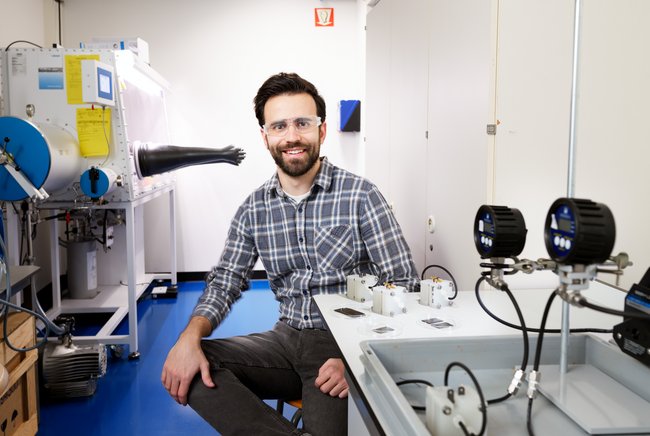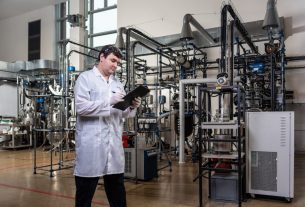The Netherlands/US – A relatively unknown type of battery – the redox-flow battery – is very promising for large-scale energy storage. To improve the electrochemical reactions in this battery, a team of researchers from Eindhoven University of Technology (TU/e), DIFFER and MIT developed a completely new electrode with ‘honeycomb’ pores.
With this material, the battery becomes more efficient and can be tailored to many different applications. Moreover, the new electrode is easier and cheaper to produce and suits large-scale manufacturing.
All batteries work on redox reactions; molecules that exchange electrons. The reductant loses an electron after which the oxidant absorbs an electron. When separated, which is the case in a battery, the resulting charge difference creates a current of electrons: electricity. A battery consists roughly of four parts: electrodes on both sides that initiate the redox-reaction, an electrolyte with the reductant and oxidant (positive and negative poles) where the reaction takes place, a membrane to keep the two electrolytes separate and an external electrical circuit.
Large pores
Batteries generate most power when the electrons flow fast. The electrode of a redox-flow battery therefore has a porous structure. Lead researcher Antoni Forner-Cuenca from TU/e: ‘The larger the pores, the easier the electrolyte can flow through and the lower the pressure loss. However, if the pores are too large, we renounce surface area. In an ideal situation, you would like both a high flow rate and a large reaction surface.’
At this moment, redox-flow batteries use conventional carbon fiber electrodes, the electrode type designed for low temperature fuel cells. However, these electrodes are complex and expensive to produce, and the production process makes the three-dimensional structure of the pores difficult to adjust to the desired application.

Membrane technology
Forner-Cuenca continues: ‘To develop a better performing electrode, we went back to the drawing table. We completely reconsidered and improved the design and choice of materials. Drawing inspiration from membrane science and technology, we used polymer phase separation to control the electrode structure.
We start with a liquid solution that contains two polymers. After immersion in water, a porous structure is formed by dissolving one of the polymers, the so called pore forming agent. We can play with the composition, solvent, temperature and other parameters to precisely control the porous structure of the electrode. It was those insights that formed the basis for our new design.’
Cheaper
After numerous computer simulations and experimental work, the researchers managed to develop a material in which the pore size and shape of the electrode can be easily adjusted by varying the amounts of solvent and polymers. Forner-Cuenca: ‘The manufacturing process of our new material is much simpler and cheaper, offers larger versatility and is easier to upscale than the conventional electrode production. It shows that it is indeed possible to create an electrode with both favorable bulk electron transport and a large reaction surface.’
One of the developed structures proved to be a hit: the ‘honeycomb’ electrode shows a promising combination of large and small pores. It therefore suits the application of large-scale energy storage. The large pores guarantee the high flow rate, as if it were a highway. And the small pores in between ensure sufficient reaction surface, being the ‘regional roads’.




